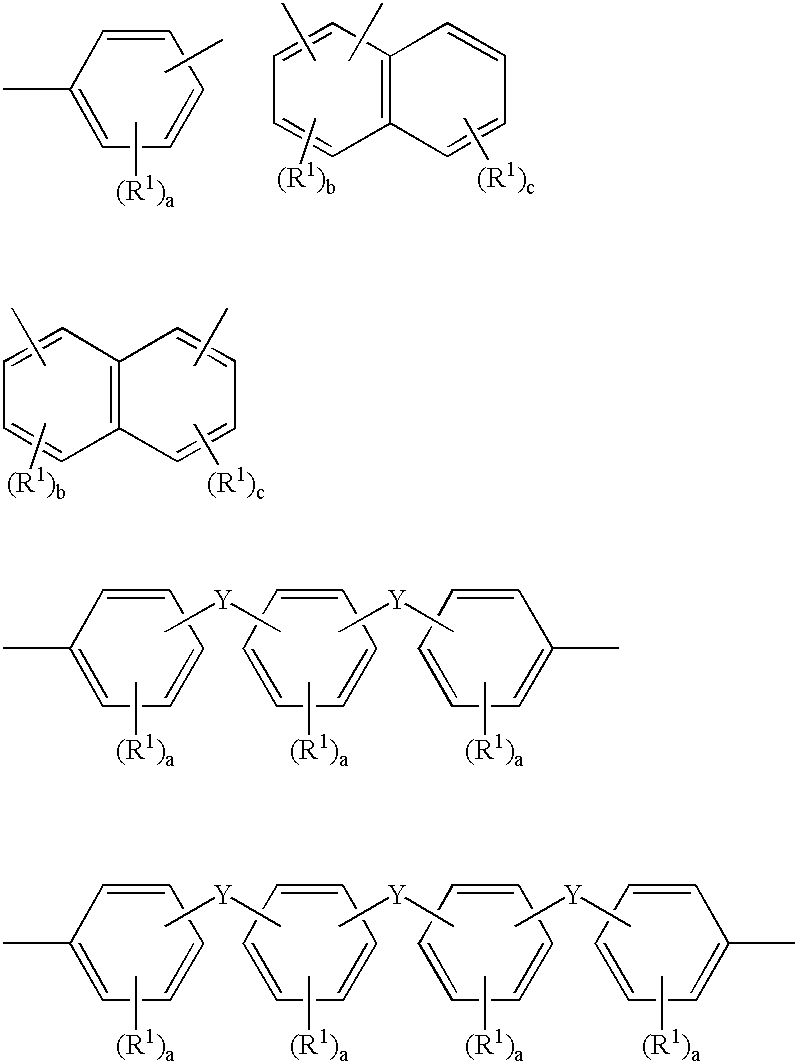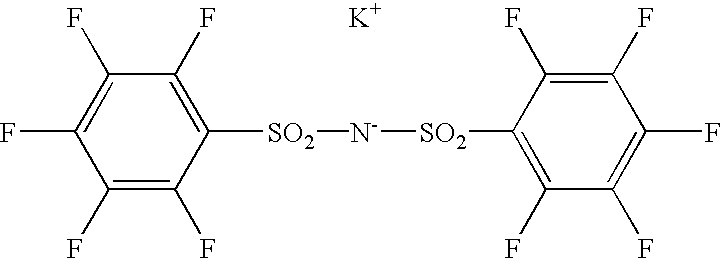Polymer electrolyte and process for producing the same
- Summary
- Abstract
- Description
- Claims
- Application Information
AI Technical Summary
Benefits of technology
Problems solved by technology
Method used
Image
Examples
synthesis example 1
Synthesis Example of a Disulfonylimide
[0067]To an aqueous solution of ammonium chloride was added dropwise an acetone solution of 1,3-benzenedisulfonyl chloride at room temperature. During addition, pH was adjusted to 7 with an aqueous sodium hydroxide solution. Precipitated product was filtered and recrystallized from ethanol to give 1,3-benzenedisulfonamide. The structure was confirmed by 1H-NMR and IR.
[0068]Then, 4 times by mole of NaH was added to a tetrahydrofuran solution of 1,3-benzenedisulfonamide. Subsequently, 2 times by mole of pentafluorobenzenesulfonyl chloride was gradually added to the mixture and allowed to react at 60° C. The reaction mass was filtered and the filtrate was concentrated. The residue was dissolved in methanol and combined with a methanol solution of KOH to give the desired sulfonylimide (may be referred to as BSI 1) in the form of potassium salt. The product was recrystallized from a mixed solvent of acetone and methanol.
[0069]1H-NMR (ppm): 7.52, 7.6...
example 1
An Alternating Copolymer Comprising BSI 1 and Biphenol
[0070]Into a flask were placed 0.500 g of BSI 1, 0.121 g of 4,4′-dihydroxybiphenyl, 94 mg of potassium carbonate and 3 ml of dimethylsulfoxide (hereinafter, referred to as DMSO) under nitrogen stream and they were heated with stirring at 100° C. for 18 hours. The reaction solution was added dropwise to 10% aqueous hydrochloric acid solution. The obtained precipitates were collected by filtration, washed with methanol and then dried under reduced pressure at 60° C. to give 0.48 g of a disulfonylimide polymer in the form of a white solid. The result of molecular weight measurement (converted to polystyrene) is shown in Table 1.
[0071]The obtained polymer was dissolved in DMAc to a concentration of about 10% by weight, casted in a glass dish and dried at 80° C. for removing the solvent to give a colorless and transparent tough film having a thickness of 105 μm. The proton conductivity of the film was measured by alternating current m...
example 2
A Random Copolymer Comprising BSI 1, Bisphenol A and Decafluorobiphenyl
[0072]Into a flask were placed 0.773 g of BSI 1, 0.435 g of Bisphenol A, 0.334 g of decafluorobiphenyl, 0.290 g of potassium carbonate and 7.5 ml of DMSO under nitrogen stream and they were heated with stirring at 80° C. for 30 hours. After completion of the reaction, the reaction solution was added dropwise to 10% methanolic hydrochloric acid solution. The obtained precipitates were collected by filtration, washed with methanol and then dried under reduced pressure at 60° C. to give 0.93 g of a disulfonylimide polymer in the form of a pale brown solid. The results of measurement for molecular weight and 10% weight loss temperature are shown in Table 1.
[0073]The obtained polymer was converted into a film in the same manner as that in Example 1 to give a transparent and pale brown tough film having a thickness of 36 μm. The results of measurement for proton conductivity and the ion exchange capacity of the film ar...
PUM
| Property | Measurement | Unit |
|---|---|---|
| Fraction | aaaaa | aaaaa |
| Area | aaaaa | aaaaa |
| Area | aaaaa | aaaaa |
Abstract
Description
Claims
Application Information
 Login to View More
Login to View More - R&D
- Intellectual Property
- Life Sciences
- Materials
- Tech Scout
- Unparalleled Data Quality
- Higher Quality Content
- 60% Fewer Hallucinations
Browse by: Latest US Patents, China's latest patents, Technical Efficacy Thesaurus, Application Domain, Technology Topic, Popular Technical Reports.
© 2025 PatSnap. All rights reserved.Legal|Privacy policy|Modern Slavery Act Transparency Statement|Sitemap|About US| Contact US: help@patsnap.com



